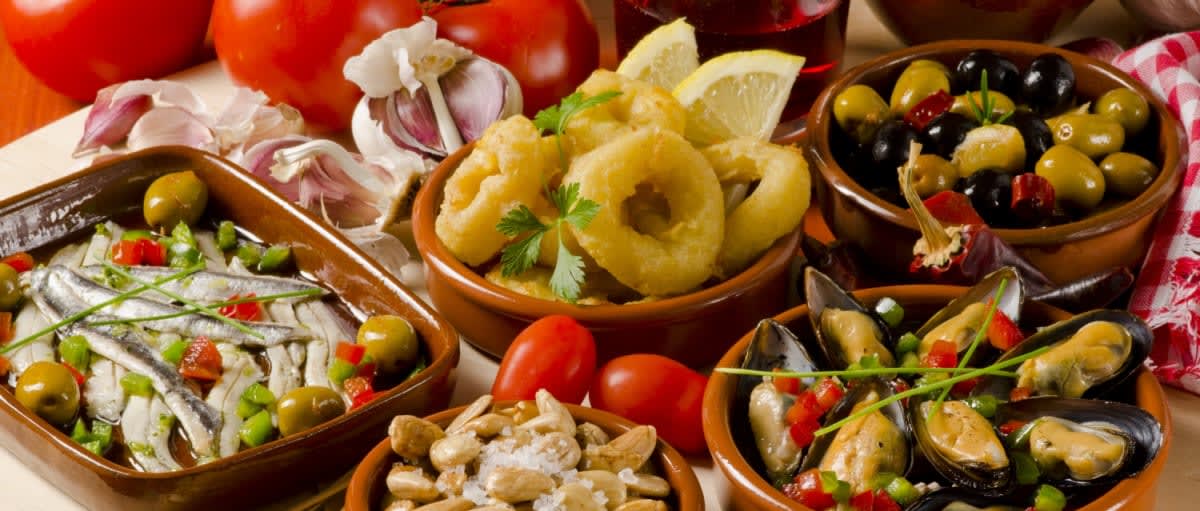Food is at the heart of Spanish life. From paella in Valencia to pintxos in the Basque Country, Spain’s cuisine is as varied as its regions. Here’s your guide to the dishes and drinks you can’t miss when exploring your new home country.
Spain holds a special place in the international culinary scene. The country appears 32 times on the Opinionated About Dining list of Europe’s Top 150 Restaurants – more than any other nation. That reputation has helped cement Spain’s position not just as a holiday destination but as a true gastronomic leader.
If you’re passionate about food, exploring Spain through its regional dishes is one of the best ways to connect with the culture, whether you’re dining in a Michelin-starred restaurant or a tiny village bar. Spanish chefs like Bittor Arginzoniz at Asador Etxebarri and Quique Dacosta in Dénia have earned global acclaim, but it’s the everyday plates you’ll discover across Spain that make living in the country so rewarding.
Download the Spain Buying Guide
Andalusia
Andalusia is the birthplace of sherry, which features not only as a drink but also in many local dishes. Influenced by Moorish flavours, you’ll taste spices such as saffron, cinnamon and nutmeg. Even simple picada – a paste of garlic, bread, nuts and olive oil – gives sauces and stews incredible depth. Cookbooks such as Rick Stein’s Spain celebrate Andalusian cooking, with recipes like prawn fritters or olives stewed with sherry vinegar and orange.
Valencia
Paella may be Spain’s most famous dish, but for locals it belongs firmly to Valencia. Traditional paella often includes rabbit or chicken alongside beans and saffron. If you want to experience it the local way, head to small restaurants along the coast or in rural areas where it’s still cooked over a wood fire. Other favourites include all i pebre, a rustic eel stew thickened with almonds and flavoured with garlic and paprika. For something simpler, try grilled mushrooms drizzled with olive oil – a staple at many Valencian barbecues. You’ll also find monkfish with saffron rice in smaller coastal restaurants where locals go.
Catalonia
Because Catalonia stretches from the Pyrenees to the Mediterranean, its cuisine blends the sea and mountains in dishes known as mar i muntanya. One of the most common dishes is Arroz de casola (Catalonia’s take on paella) – you’ll see it advertised outside local restaurants, especially on Thursdays. Vegetable lovers should try broad beans cooked with young garlic and black sausage or bacon, sometimes enhanced with a splash of aniseed spirit such as Pernod. Meanwhile, Catalan braised rabbit is famous across Spain for its nut-and-wine sauce, which works beautifully in a slow cooker at home. And for the ultimate simple classic, pa amb tomàquet – bread topped with juicy tomatoes, garlic and olive oil, paired with Iberico or Serrano ham.
Extremadura
Extremadura is an agricultural region, which explains why lamb, sheep’s cheese and Iberico ham are so central to its food culture. Torta de la Serena, a gooey sheep’s cheese from Cáceres, is eaten with bread or spooned straight from its rind. In colder months, caldereta de cordero – lamb stew with garlic, peppers, onions and white wine – is the go-to dish.
Galicia
Galicia’s wet, green landscape produces excellent vegetables, but its ports at Vigo and La Coruña make seafood the star. Locals swear by pulpo a la gallega, octopus boiled with potatoes then sprinkled with paprika and sea salt. Another Galician treat is pimientos de Padrón, small peppers fried until blistered – some mild, some surprisingly hot. With the Atlantic Ocean on its doorstep, the region’s restaurants serve some of the best fish you’ll find in coastal Spain.
Basque Country
The Basque Country is a global culinary hotspot, home to multiple Michelin-starred restaurants – San Sebastián alone has 11! Beyond fine dining, everyday Basque food is just as exciting. Pintxos (tapas) bars line the streets, serving everything from anchovies to chorizo on slices of bread. Cod, often salted then rehydrated, appears in countless recipes. Pollo a la vasca, or Basque chicken, showcases peppers and onions cooked slowly until rich and sweet. For dessert, burnt Basque cheesecake has become a worldwide sensation, with its caramelised top and creamy centre. Pair it with local cider, poured from a height in traditional style to release its natural fizz.
Frequently asked questions
Tapas, paella and Iberico ham are among the most popular foods. Wine, beer and coffee are everyday staples, with regional favourites like cider in the Basque Country and sherry in Andalusia.
Paella is widely recognised as Spain’s national dish, although it originates from Valencia. Sangria – red wine with fruit and a spirit such as brandy – is considered Spain’s national drink.
Spain is renowned for its wines, including Rioja and Ribera del Duero reds, Cava sparkling wine and Andalusian sherry. Sangria is also popular.
You might also like:









